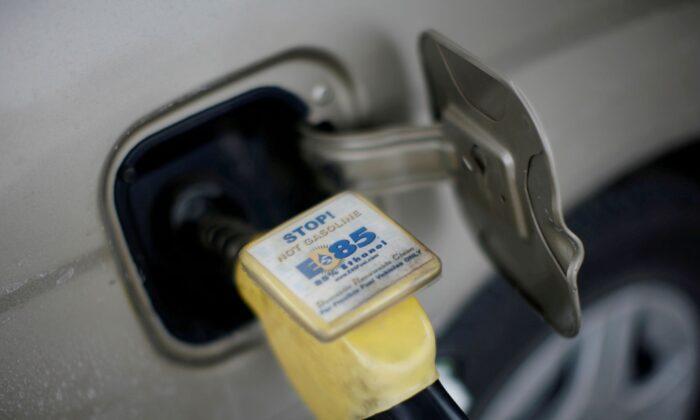The Environmental Protection Agency (EPA) on June 21 unveiled its Renewable Fuel Standard, increasing the amount of biofuels that American refiners must blend into the nation’s fuel supplies from 2023 to 2025, but keeping in place lower mandates for homegrown corn-based ethanol.
Overall, volumes of conventional renewable fuels, which includes corn ethanol, are set at 15 billion gallons for the next three years, along with a supplemental volume requirement of 250 million gallons of renewable fuel for 2023.
That amount represents a decrease from December’s original proposal, which included 15 billion gallons of conventional biofuels in 2023 and 15.25 billion in both 2024 and 2025.
Currently, the majority of gasoline sold in the United States is 10 percent ethanol, despite a handful of ethanol plants being forced to shut down amid waning fuel consumption during the COVID-19 pandemic.

Industry Backlash
The administration’s cut to ethanol came as a disappointment for members of the biofuel industry and farm advocates.“While we are encouraged that EPA continues to call for higher volumes of renewable fuels year over year, we are disappointed that the final RVOs [renewable volume obligations] are significantly lower than originally proposed for conventional and cellulosic biofuels,” Reid Wagner, executive director of the Nebraska Ethanol Board, said in a statement Wednesday.
“Our current ethanol infrastructure has the capacity today to easily meet the originally-proposed 15.25 billion gallons of conventional biofuel requirement, and a growing number of ethanol producers are deploying technologies for processing corn kernel fiber into ethanol, which will contribute significant volumes of cellulosic biofuel soon,” Wagner continued.
“Ensuring adequate RVOs aids in market development as the ethanol industry works to expand access to its products. By sidelining these low-carbon biofuels options, EPA is effectively leaving tools in the box that could be used to accomplish their decarbonization goals,” he added.
Emily Skor, CEO of biofuels trade association Growth Energy, took aim at the new fuel standards, stating that EPA’s decision to “lower its ambitions for conventional biofuels runs counter to the direction set by Congress and will needlessly slow progress toward this administration’s climate goals.”
“We should be expanding market opportunities for higher blends like E15, not leaving carbon reductions on the table,” Skor said in a statement. “While the final rule offers a modest improvement in advanced volumes, EPA inexplicably failed to extend that recognition to conventional biofuels. The bioethanol industry has more than adequate supply to meet the higher volumes that were originally proposed in December 2022.”
“Choosing not to put that supply to good use in decarbonizing the transportation sector runs counter to this administration’s previously-stated commitments and undermines the goal of reaching net-zero by 2050,” Skor concluded.

‘Inexplicable and Unwarranted’
Elsewhere, the Renewable Fuels Association (RFA) called the EPA’s decision “inexplicable and unwarranted” adding that it “misses a valuable opportunity to accelerate the energy sector’s transition to low- and zero-carbon fuels.”“By removing half a billion gallons of lower-carbon, lower-cost fuel, today’s rule needlessly forfeits an opportunity to further enhance U.S. energy security and provide more affordable options at the pump for American drivers,” RFA President Geoff Cooper said in a statement.
However, in a statement announcing the new renewable fuel standards, the EPA said the final rule builds on the Biden administration’s “commitment to strengthen the nation’s energy independence, advance low-carbon fuels, and support agricultural communities.”
The agency said the new rule will strengthen domestic energy security by reducing reliance on foreign sources of oil by around 130,000 to 140,000 barrels of oil per day over the next three years.
Additionally, the anticipated value of the energy security benefits to the U.S. economy could reach up to $192 million per year over the three-year period, according to EPA estimates.
EPA Administrator Michael Regan went on to praise the agency’s commitment to the growth of renewable fuels which he said play a critical role in “diversifying our country’s energy mix and combating climate change, all while providing good paying jobs and economic benefits to communities across the country.”
“Today’s final rule reflects our efforts to ensure stability of the program for years to come, protect consumers from high fuel costs, strengthen the rural economy, support domestic production of cleaner fuels, and help reduce greenhouse gas emissions,” Regan said.
Notably, Wednesday’s final rule also did not include widely-anticipated pathways for electric vehicle manufacturers to generate credits under the new standards, despite such pathways being included in December’s original proposal.
However, it did include incentives sought to bolster the use of biogas from farms and landfills, among others.





